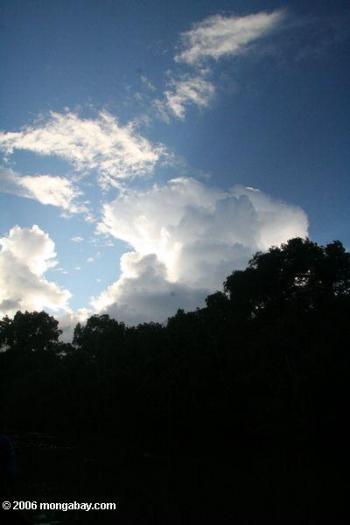Researchers recently traveled to the remote Brazilian Amazon to investigate how clouds are formed and rain falls in an atmosphere unburdened by human-caused pollution. Studying the atmospheric aerosol particles, which impact cloud formation and particles, above a pristine forests, researchers discovered that when left alone the Amazon acts as its own ‘bioreactor’: clouds and precipitation are produced by the abundance of plant materials.
“The trees basically ‘sweat out’ organic molecules that react with compounds in the atmosphere, producing tiny particles that are around 20 to 200 nanometers in size,” explains Markus Petters, an assistant professor at North Carolina State University and one of the members of the study, in a press release. “These particles seed the clouds. In addition, other biological particles form the ice nuclei for the clouds.” Such ice nuclei are essential for the formation of precipitation.
 Clouds forming over the Amazon rainforest in Colombia. Photo by: Rhett A. Butler. |
In other words, in a pristine rainforest clouds and precipitation are both instigated by organic materials from the forest such as plant debris, pollen, fungal spores, and bacteria. According to the study 80 percent of supermicron particles—with a diameter greater than a micrometer—in the atmosphere were produced by the Amazonian life. These supermicron particles form the ice nuclei, which eventually lead to precipitation. Therefore the scientists say that the abundant life of the Amazon essentially creates the clouds and precipitation that sustains it.
“The Brazilian rainforest during the rainy season can be described as a bioreactor”, says Ulrich Pöschl of the Max Planck Institute for Chemistry, adding that “we are already able to say that the number of cloud droplets over the Amazon rainforest is aerosol-limited, which means that it depends on the number of aerosol particles which is released by the ecosystem.”
If the ecosystem is lost, so are the aerosol particles needed to form clouds and produce precipitation.
Petters says that he hopes the study will help scientists worldwide better understand how human activities are changing the world’s climate.
“The Amazon is unique in that it provides a good place for us to observe atmospheric interactions without human influence, and to catalog baseline activity for the rainforest,” he explains. “If we understand that baseline well enough around the world, we can run simulations that show how human aerosol emissions modulate climate change.”
The Amazon rainforest is the world’s largest, yet it faces myriad threats from commercial agriculture, cattle ranching, logging, oil and gas, dams, road construction, and slash-and-burn farming. From 1970-2005, the Amazon has been reduced by 600,000 square kilometers (232,000 square miles) in Brazil, an area the size of Ukraine and nearly 20 percent of Brazil’s total rainforest.
Citation: U. Pöschl, S. T. Martin, B. Sinha, Q. Chen, S. S. Gunthe, J. A. Huffman, S. Borrmann, D. K. Farmer, R. M. Garland, G. Helas, J. L. Jimenez, S. M. King, A. Manzi, E. Mikhailov, T. Pauliquevis, M. D. Petters, A. J. Prenni, P. Roldin, D. Rose, J. Schneider, H. Su, S. R. Zorn, P. Artaxo, M. O. Andreae. Rainforest Aerosols as Biogenic Nuclei of Clouds and Precipitation in the Amazon. Science 17 September 2010: Vol. 329. no. 5998, pp. 1513-1516. DOI: 10.1126/science.1191056
Related articles
Healthy coral reefs produce clouds and precipitation

(03/03/2010) Twenty years of research has led Dr. Graham Jones of Australia’s Southern Cross University to discover a startling connection between coral reefs and coastal precipitation. According to Jones, a substance produced by thriving coral reefs seed clouds leading to precipitation in a long-standing natural process that is coming under threat due to climate change.
Air pollution in China reduces rainfall
(08/31/2009) Air pollution in eastern China over the past half century has reduced rainfall and exacerbated the risk of drought and crop failures, reports a study published in the Journal of Geophysical Research.
Massive deforestation in the past decreased rainfall in Asia

(06/25/2009) Between 1700 and 1850 forest cover in India and China plummeted, falling from 40-50 percent of land area to 5-10 percent. Forests were cut for agricultural use across Southeast Asia to feed a growing population, but the changes from forests to crops had unforeseen consequences. A new study published in the Proceedings of the National Academy of Sciences links this deforestation across Southeast Asia with changes in the Asian Monsoon, including significantly decreased rainfall.